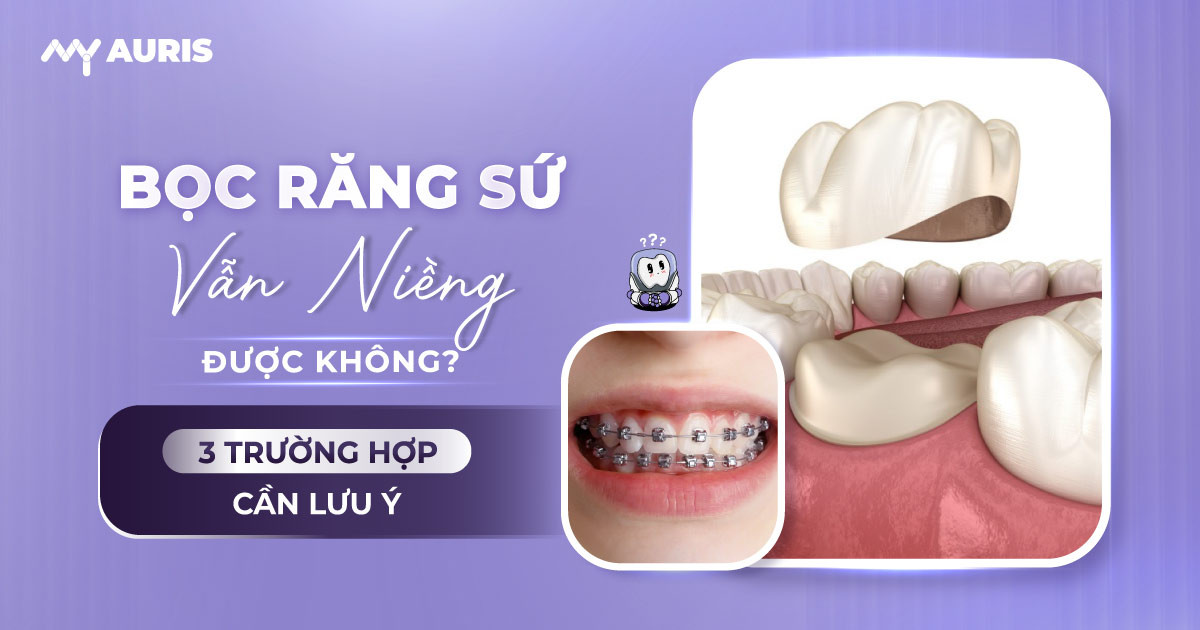During the consultation and implementation of orthodontic treatment, we have received many questions related to the appropriate age and effective orthodontic methods. One of the most common questions, as porcelain crown technology develops alongside braces, is: “Can porcelain crowns be braced?” To help you understand this issue from a professional perspective, the article below from My Auris will provide detailed analysis from orthodontic experts, helping you make the most suitable choice for your teeth.
Already have porcelain crowns, why would braces still be needed?
There are two common scenarios that lead to the need for braces after getting porcelain crowns:
Case 1: Porcelain crowns due to pathology
If you have porcelain crowns to treat tooth decay, cracked teeth, or replace missing teeth with a dental bridge, you can still get braces normally. This is because porcelain crowns are usually located in specific areas, primarily the molars, so orthodontic treatment to restore the aesthetics of the front teeth typically doesn’t encounter too many difficulties.
Case 2: Cosmetic porcelain crowns but not achieving desired results
Many people choose porcelain crowns to improve conditions like protrusion (overjet), underbite, or malocclusion, but later become dissatisfied with the outcome. If they had considered more carefully and opted for braces from the start, their face might have been more balanced. However, porcelain crowns only help change the shape of teeth and cannot adjust the jawbone. This leads some people to regret not choosing braces sooner.
Porcelain crowns only improve dental aesthetics but cannot change the relationship of the jawbones. Due to a lack of understanding, some people expect porcelain crowns to completely fix protrusion. But after the procedure, they realize that their teeth have been ground down and cannot be restored to their original state.It is entirely possible to get braces on porcelain crowns, but because the surface of porcelain crowns is smooth and hard, brackets may have more difficulty adhering compared to natural teeth. However, thanks to technological advancements, there are now special etching acids and specialized bonding agents that help brackets adhere more firmly, supporting a more effective bracing process.
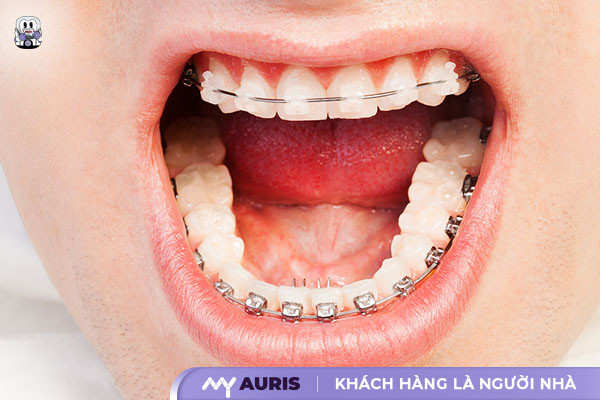
Can you get braces with porcelain crowns?
Is it possible to get braces after getting porcelain crowns (dental crowns)? The answer is yes, but it requires evaluation based on several important factors: Getting porcelain crowns means grinding down natural teeth. If the remaining tooth structure after grinding is sufficient, the likelihood of successful orthodontic treatment is higher. When getting braces, brackets will be attached to the porcelain crowns to transmit force, but because porcelain crowns are not like natural teeth, their movement capability will be limited. During treatment, porcelain crowns may chip or even need to be entirely replaced after braces. Therefore, evaluating the amount of remaining tooth structure is crucial.
If porcelain crowns are not sealed tightly or do not adhere well, they may come off during the bracing process. The tight seal also helps ensure oral health and protects the underlying natural tooth structure. To assess this, the dentist will use instruments to check the base of the porcelain crown. If gaps or decay are found, you may need to have the porcelain crowns redone before getting braces.
The dentist will check if the tooth has undergone root canal treatment by listening for a sound when tapping the tooth. Cases of tooth misalignment, protrusion, or underbite might have involved multiple root canal treatments, which makes teeth brittle and reduces their ability to move during bracing. If the tooth pulp has been completely removed, especially for an entire arch, successful orthodontic treatment becomes very difficult.
For severe cases of protrusion or underbite that require extensive tooth movement, the dentist must assess whether braces can be performed while maintaining healthy tooth roots within the jawbone. If the pulling force is too strong, teeth could be dislodged from the bone or suffer root resorption.
Currently, Invisalign clear aligners are an ideal method for individuals who have full-arch porcelain crowns. Unlike traditional braces, Invisalign uses removable clear plastic trays, which help protect the surface of porcelain crowns. This method doesn’t require brackets, thus limiting damage and potentially allowing existing porcelain crowns to be retained. However, the cost of Invisalign treatment is typically higher than other methods.
When to choose braces, and when to choose porcelain crowns?
To save time and costs, you need to clearly determine when to opt for braces and when to choose porcelain crowns to achieve optimal dental aesthetics.
When should you get braces?

Protruding teeth (Overjet)
Protruding teeth (overjet) is a condition where the upper jawbone or teeth protrude forward compared to the lower jaw, causing aesthetic issues and affecting chewing function. Depending on the severity, the dentist will recommend a suitable orthodontic method to improve the bite and oral health.
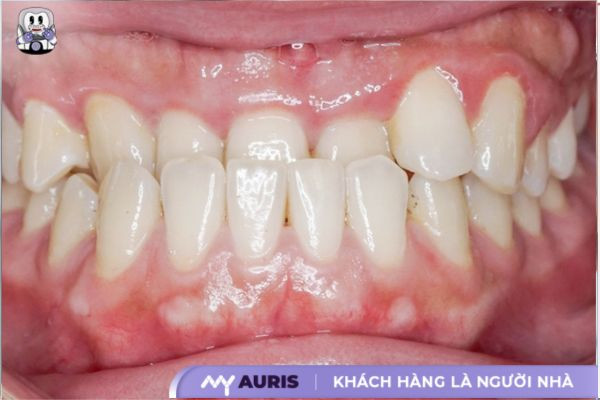
Underbite
An underbite (Class III malocclusion) is a severe form of bite misalignment where the upper jaw retracts inward compared to the lower jaw. This not only affects the aesthetics of the smile but also reduces chewing function, requiring orthodontic intervention to achieve a correct bite.

Crowded, crooked teeth
Crooked and crowded teeth lead to an unbalanced dental arch, making oral hygiene difficult and increasing the risk of tooth decay and gum inflammation. Braces help realign teeth, protecting long-term oral health.
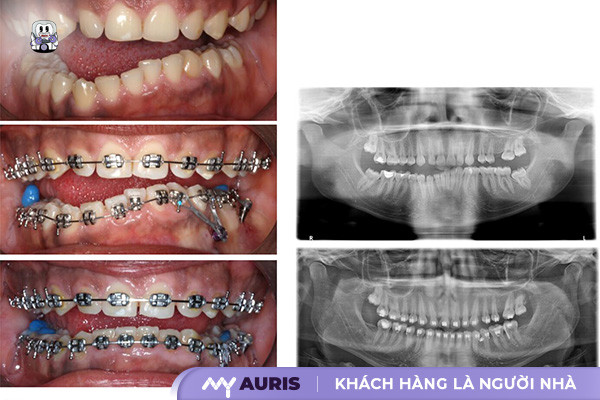
Malocclusion
Malocclusion includes various types such as open bite, deep bite, edge-to-edge bite, etc. These conditions not only cause self-consciousness during communication but also affect pronunciation and chewing function. Orthodontic treatment helps move teeth into their correct positions, balancing the bite.
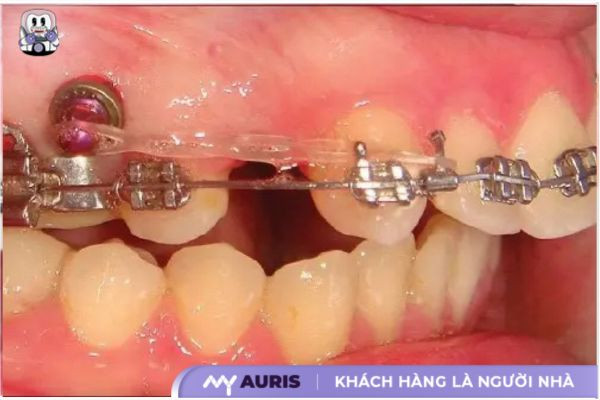
Closing spaces from missing teeth
In cases of missing teeth, braces can help move wisdom teeth to replace a missing molar (tooth #7) if the latter cannot be saved. This treatment method helps maintain jawbone structure and optimizes chewing function.

Gaps between teeth (Diastema)
Diastema is a condition where teeth are spaced far apart, creating gaps in the dental arch, affecting smile aesthetics and chewing ability. Using orthodontic appliances helps move teeth into their correct positions, improving aesthetics and protecting oral health.
When should you get porcelain crowns?
Severe tooth decay
If a tooth has severe decay, has undergone root canal treatment, but fillings are not effective, the dentist will examine the tooth root condition. If the tooth root is still strong, porcelain crowning is an optimal choice to protect the natural tooth stump, prevent bacterial growth, and maintain oral health.
Damaged, non-vital teeth
Teeth that have undergone root canal treatment become brittle and prone to fracture because they are no longer nourished. Porcelain crowns help protect the natural tooth, increase its durability, and ensure better chewing function.
Uneven teeth
In cases of slightly crooked, uneven, or tilted teeth, porcelain crowns help reshape the teeth, providing a beautiful white and harmonious smile, enhancing dental aesthetics.
Mild overjet or underbite
If the overjet or underbite is caused by the teeth (not the jawbone), porcelain crowns can significantly improve the condition without the need for braces, giving you a more balanced smile.
Gapped teeth, spaces between teeth
Modern porcelain crown technology can fix mild cases of gapped teeth, filling the spaces between teeth, ensuring both aesthetics and not affecting chewing function.
Severely stained, discolored teeth
If teeth are discolored due to tobacco, coffee, alcohol, or tetracycline staining from antibiotics, teeth whitening may not achieve optimal results. In such cases, porcelain crowns or porcelain veneers are ideal methods to achieve naturally bright and durable teeth.
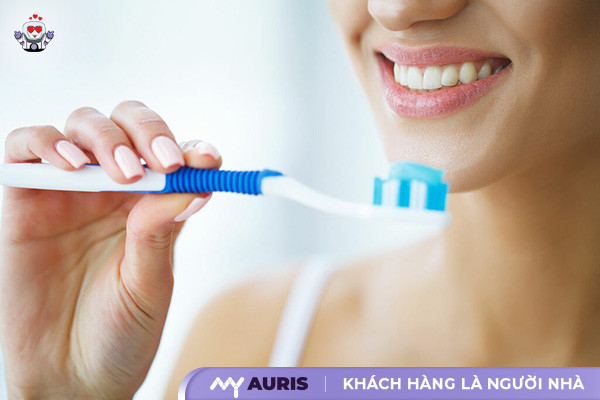
Things to know when getting braces after porcelain crowns
Have you already had porcelain crowns but still want orthodontic treatment for a straighter, more beautiful smile? To ensure a smooth bracing process on porcelain crowns, please note the following important points:
First, visit a reputable dental clinic for a dentist to assess your oral health. A dental consultation will help you determine whether getting braces on porcelain crowns is suitable, avoiding risks that could affect tooth enamel and overall health.
Brush teeth 2-3 times a day with a soft-bristle toothbrush and fluoride toothpaste to protect tooth enamel.
Use dental floss, a water flosser, and mouthwash to remove plaque and oral bacteria, preventing tooth decay.
Undergo regular dental check-ups to detect oral health issues early.
Limit sugary and starchy foods like candies and soft drinks to reduce the risk of tooth decay.
Avoid acidic foods like oranges, lemons, grapefruits, etc., as they can erode tooth enamel.
Abstain from dark-colored foods and drinks such as coffee, wine, beer, and tobacco to prevent teeth from staining.
Do not eat excessively hard or chewy foods as they can affect porcelain crowns and the brace system.
Follow a diet for people with braces, supplementing vitamins and fiber from fruits and vegetables, and protein from meat and fish to strengthen the resistance of teeth and gums.
Full porcelain crowning does not completely impede the orthodontic process, but dentists always recommend having a sensible dental treatment plan from the outset to avoid unexpected costs and maximize the aesthetic protection of your teeth. If you have any questions, visit a reputable cosmetic dental clinic for advice on modern orthodontic techniques suitable for your dental condition.
We hope this article helps you make the right decision regarding the porcelain crowning process and getting braces after porcelain crowns, effectively and safely!


